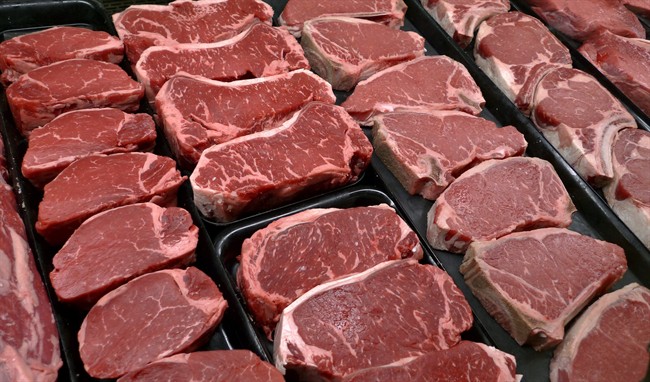A drop in prices at the pump is putting a little more cash in consumers’ pockets this fall – but much of those savings may well be paying for higher grocery prices, notably red meat.

Gas prices fell 4 per cent last month compared to September, Statistics Canada said Friday. It was the fourth month in a row retail pump prices have declined as demand for oil cools down globally and supply levels rise.
“Pump prices plunged in the month,” Benjamin Reitzes, an economist at Bank of Montreal said. Still, costs are climbing on almost everything else thanks in part to the tumbling value of the loonie, he said.
“While the drop in energy prices in recent months has weighed heavily on inflation, the accompanying weakness in the Canadian dollar has the opposite impact, pushing prices higher,” Reitzes said.
The loonie is currently plumbing five-year lows, trading around 88 cents U.S.
MORE: Consumer prices pop unexpectedly higher in October
No more is the effect of a weaker currency more visible than in fresh food prices, and more specifically the cost of red meat, which have surged this year on supply shortages for beef and pork. The falling loonie is compounding the price pressures, with big Canadian buyers competing with U.S. customers who can pay with U.S. dollars.
‘Customers have to adjust to a new price reality’
No relief
Dry goods, bakery items and other grocery products have seen muted price gains – even deflation in the case of bread – this year. But produce prices have risen steadily higher, and in the case of red meat, substantially so.
Meat prices at the supermarket were up a whopping 12.4 per cent last month. And if not for a more modest rise in the retail cost of poultry that figure would be even higher (see chart). Several individual cuts of pork and beef continue to show year-on-year spikes north of 20 per cent.
La Flèche said Metro, like other chains, is absorbing some of the cost increases but most of the inflation is passing through to the customer. “We’ve passed most of it, but not all of it,” he said.
Selecting cheaper meat alternatives has become the default of many shoppers at Metro and other supermarket chains. “When prices spike up, consumers trade down or choose something else,” La Flèche said.
- ‘Shock and disbelief’ after Manitoba school trustee’s Indigenous comments
- Invasive strep: ‘Don’t wait’ to seek care, N.S. woman warns on long road to recovery
- ‘Super lice’ are becoming more resistant to chemical shampoos. What to use instead
- Canadian food banks are on the brink: ‘This is not a sustainable situation’
MORE: Time to go vegetarian? Meat prices stay ‘persistently strong’
Red meat price gains should level off by the middle of next year and perhaps begin to come down as more supply becomes available, forecasters say. But costs will remain elevated through the early months of 2015.
“We don’t expect meat prices to drop anytime soon. In fact, we do expect moderate increases in the new year,” Sylvain Charlebois, an agriculture and food industry professor at the University of Guelph said.
Charlebois said many consumers could begin seeking alternatives like nuts or soy-based products.
“An increasing number of consumers will look for vegetable proteins, or more affordable proteins in the new year. Some may even become ‘flexatarians,’” Charlebois suggested.
“Customers have to adjust to a new price reality,” Metro’s La Flèche said.



Comments